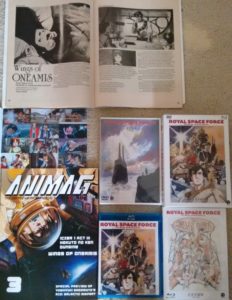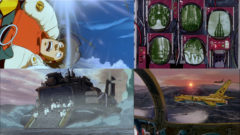
Actually, this one was made 32 years earlier but I had too much research on this story of how good can come from failure. So, in that vein, it’s time for the way back machine to celebrate a little history. Some of you reading this are relatively new to the anime hobby, having hopped into fandoms such as Kill La Kill and Gurren Lagann, either via streams or watching shows on Toonami. Others may have taken in Toonami many years earlier when the whacked out series FLCL (Fooly Cooly) was broadcast on there. Others still may have learned about the existence of the animation studio GAINAX when the controversial mecha-Christian mindscrew known as Neon Genesis Evangelion changed how many could view the powerful potential of animated storytelling in both Japan and the United States.
There are other high points in the history of GAINAX and its offshoots. But many of them might not be possible if it weren’t for a simple vegetable: the radish. Known to the Japanese as ‘Dai’ It’s apparently a fun vegetable that it inspired a sci-fi convention called Daicon. Co-chairs Toshio Okada and Yasuhiro Takeda commissioned young director Hiroyuki Yamaga to create an opening animation video for two of the events, utilizing everything in Japanese and American sci-fi, comics and animation centered around a single red-haired girl fighting off every conceivable figure in popular fiction, eventually adorning a Playboy bunny outfit in the second video. (FLCL ep. 5 make a little more sense now?)
Soon after Daicon IV, these three men got together with character designer Yoshiyuki Sadamato and animation veterans Hideki Anno and Takami Akai to eventually produce a short film based primarily on Yamaga’s story concepts. During this, they eventually formed an animation company called GAINAX (which means ‘big’ in Sanin dialect) and filed their business license on Christmas Eve 1984. The following year, they finished the short and presented it to Bandai Company Limited, a toy company at the time who was looking to branch into filmmaking. Having secured funding here, Gainax worked hard to create their first feature-length film, the focus of this article entitled Wings of Honneamise: Royal Space Force. Under Yamaga’s direction, Honneamise was full of incredible detail and tons of key animation techniques, setting a standard in motion picture quality that none could match at the time, which turned out to be both a boon and a detriment to the film.
Taking place on a fictional world similar to Earth, we meet Shirotsugh Lahdatt, a young man who had just graduated high school of sorts and wanted to join the Navy as a pilot to fulfill his dream of flying. However, his grades are too low so he joins the space force instead. This world’s version isn’t quite like NASA though as there hasn’t been a successful manned spaceflight yet, due to technical failures and astronaut deaths. Although decently funded, it is still considered somewhat a joke as an organization. When we see him initially, Shiro is arriving late for the funeral of the last test pilot (much to his commander’s chagrin of course.) He appears to take very little seriously except his desire to fly and worries about having a job if the Space Force doesn’t work out. He muses on this again during physical training…. which his C.O. doesn’t take to well, earning Shiro a long lecture and LOTS of push-ups.
Later, Shiro and his comrades hit the city to toast their fallen friend and drown their sorrows. Eventually, everyone splits off and Shiro winds up exploring the city alone until he comes across a lone woman speaking about the final days of judgment and God’s plan for humanity. Shiro takes one of her fliers and heads off. The next day, he wakes up and heads out of the city to find the church address listed on the flier and finds…. a single run-down home occupied by a very quiet little girl named Manna and the woman from last night, who is very surprised Shiro came. She introduces herself as Riquinni and has Manna help prepare a meal for Shiro before they begin philosophizing about humanity’s current economic plights, God’s ways, and other things.
Back at the base, Shiro walks around with a bit more intensity and focus than before. He even attends the daily briefing in proper uniform for once. This is where the commander tells them that the military is considering scrapping the program entirely since no manned flight has been successful and only small objects have been launched into space. When he decides the only way to have all their hard work count for something is to finally have a successful manned spaceflight, he asks for volunteers. Three guesses who is the only person to raise his hand. However, there are some in neighboring countries who do not want to see the space force succeed and so the effort to send Shiro into the skies becomes a race against bureaucratic interference and dangerous outside interests threatening them all.
Back in the 80s among fan circles, Wings of Honneamise was often referred to as a cross between The Right Stuff and An Officer & A Gentleman. Basically, we have an aspiring astronaut who needs to grow up a bit and appreciate the world around him. He does eventually get to accomplish his goal, but it really is the build up to that point that makes this movie worthwhile. Watching him mature and develop a decent rapport with Riquinni and Manna is pretty involving, as much as his training and avoiding conspiracies surrounding the launch. But then we get to the launch itself after all the anticipation and efforts to help (and stop) Shiro, war breaks out and it’s truly one of the most magnificent sequences ever in animation history. I’m trying not to throw too much hyperbole into this description but this is one sequence where words do not do justice to the animation, sounds effects and timing of the music cues presented in this scene. It’s an excellent payoff for everything that has come before, and the denouement is wonderful to chill to afterward with so much imagery in the final montage. The movie is almost perfect… except for one scene. Anyone who watches the movie knows of this scene. I won’t repeat it here just yet, but when it’s spoken about, everyone has the same pained reaction to it. When Honneamise was released in the U.K., this scene was removed entirely, which sounds like a perfect version of the movie to me, but we’ll talk more on this a little later.
Yamaga used 3000 animators on the film which was a serious commitment of resources. The amazing key animation flow was matched only by the background details which were as intricate as could possibly be. The setting of Naghatsumih City was designed similarly to Osaka where Gainax was founded. The animation team got inspiration and technical advice while visiting the Smithsonian in Washington DC and attending the launch of the space shuttle Discovery Florida. These trips inspired the team so much to be as realistic as possible that they created their own CG program to simulate metal flakes falling off during the climatic launch sequence. Yoshiyuki Sadamato did some co-direction work with Yamaga, but focused primarily on character design. In trying to emulate Hollywood actors of the time, he modeled Shiro after Treat Williams (Deep Rising) and his best friend after Harrison Ford (Indiana Jones). Rinna was based on the tomboyish Tatum O Neal (Paper Moon) and Shiro’s teacher/commander was made to look like Lee Van Cleef (The Good The Bad and The Ugly).

Composer Ryuichi Sakamoto handled soundtrack duties for a style meant to be different than standard orchestral style in most films. Sakamoto used various sound sampling techniques and electronic types to create what sounds like Japanese steampunk of sorts. It was truly a unique collection at the time. Sadamoto himself had carved a name for himself on two fronts as both a musician and actor in Merry Christmas Mr. Lawrence and for his music work on The Last Emperor, which garnered him major awards. The latter caused him to have a bit of conflict with the Gainax crew as he would frequently fly off to London to work on LE and communicate production notes based on initial storyboards to the animators. Eventually, it all worked out though. Later in life, he returned to prominence garnering many nominations and awards for composing the score for 2015’s The Revenant.
Honneamise had a strange road in both Japan and in the United States, where it apparently debuted as a special screening in February of 1987, 3 months before being released in Japan. A company called Go East created an English language dub for the film and renamed it Star Quest, with extra bits of monologue to give the film a heavier and in some instances a bit more of a religious tone. It was never shown again after this screening and never released on any of the home video releases as key industry figures were apparently very unhappy with this dub.(Side note: I recently got a copy of this dub. I can understand the displeasure.)
Speaking of which, as this film is now over 30 years old, it got many high-end releases in Japan soon after its theatrical run, including the uber $80 LDs and +$100 VHS’s. (Yes, Japanese tapes were more expensive than laserdiscs back then. Go figure.) However, it didn’t receive any substantive English release until the mid-90s, when new companies were forming and establishing themselves as ones which would import animes uncut and in Japanese with English subtitles (after many years of works being dubbed (badly) and edited down for time and to remove adult content.) Companies such as U.S. Renditions, Viz Media, AnimEigo, AD Vision, Central Park Media and others were jumping into the market.
One company called Manga Entertainment would make its entry by taking up some licenses after U.S. Renditions / L.A. Hero went defunct. They brought over newer ones like Macross Plus and Giant Robo. However, they also took up releasing anime films into theaters, competing against Streamline Pictures at times. Thus, American art house theaters saw runs of Ghost In The Shell, Patlabor The Movie, Legend of the Overfiend and more. Manga sent promo posters and tapes to local anime clubs to promote these screenings. I still remember getting some of these at Atlanta-area Anime-X meetings for showings at either LeFont Theater downtown or at Georgia State’s Cinefest. Honneamise was no exception to the marketing as we got to see this flick on the big screen, often in English.
This particular dub was produced by the husband and wife duo Les and Mary Claypool, who oversaw many productions for Manga Entertainment and other companies prior, often working with the late Kevin Seymour. According to Les. who had been working on anime dubs for two years prior, “It was an insane time. I was working on Guyver Dark Hero when I got recruited for this. The original dub wasn’t well received. We dubbed it stateside and sent it out. Multiple entities were hiring us for multiple anime projects. Things got blurry. We were doing 70-80 hour weeks. Mary was the scriptwriter. She got the translation and went to writing. My studio’s involvement was for recording ADR. We dubbed in my garage before moving to the main office at magnitude.”

Mary, who hadn’t heard of the film before doing this project, added about her experiences as well. “We took creative liberties with script because it worked better and sounded better. The nuances were perfect. I really think it was an outstanding dub. The technique and artistry were magnificent.” She then talked about Kevin Seymour.
“Kevin was all-purpose guy. The casting was handled between Kevin Seymour’s company and Doug Stone. He put together the bible on researching and wringing talent and crammed everything into a very tight schedule. They would have casting there. Kevin and Doug they would have several choices. They would do a few line reads. Then meet with everyone involved. Kevin would do background voices alongside Steve Blum (yes of Cowboy Bebop fame) who would do 6 voices for bit characters. Kevin cast young skinny guy named Bryan Cranston. (Yes, of Breaking Bad fame.) My office is on the other side of studio. Mary would go in there and she’d find him on the computer and chase him off.”
Les continued. “Kevin was a master scheduler. Hard to dub with 20-30 actors. He is almost singlehandedly responsible for anime post-Carl Macek era 1992. He would bring manga by the truckload during the 80s and was into it at least 10 years before we started. Kevin would work with me. He. Had respect for original creators, and had a direct connection to original creators. He would call them and 4 days later a master tape came from Japan. Kevin was 120% into it.
Turning back to Honneamise, Les noted, “One of the things I liked was that they (Gainax) treated animation totally seriously. If you listen to Inoue from Gainax, talk about it, it was a miracle it ever got made. It’s a bunch of interns getting ok rates with horrible time frame. Not luxurious studio. Everybody was new.”
Manga Enterainment released the movie on VHS in 1995 in the UK and removed one (unnecessary) attempted rape scene to get a more family-friendly rating. The U.S. release left this scene intact. Subsequently, they released on DVD in the 2000s. Although it had a decent commentary by Hiroyuki Yamaga and Takami Akai, this release had extremely poor quality video-wise from double encoding resulting in heavy after-imaging in the visuals. Manga Ent said nothing was wrong with discs, and that it was the players’ fault. However, folks familiar with the technology at the time showed screencaps of Japanese R2 DVDs which looked fine, which pointed this to being a manufacturing problem that the company refused to take responsibility for.
So for a good while, fans of the film felt little hope that this movie would be released on modern format with the best possible video quality in the U.S. In the mid-2000s, a high-definition format war occurred between HD-DVD and Blu-Ray formats. During this period Bandai Visual USA (a subsidiary outside of the previously established Bandai Entertainment) decided to release higher priced anime titles targeting high-end collectors under the Honneamise label that originally produced Royal Space Force. Several titles including the Gunbuster compilation movies, Battle Fairy Yukikaze, Freedom and the Patlabor films among many others were released on this label. In 2007, Wings of Honneamise was released on both Blu-ray and HD-DVD in box sets containing their respective high-definition discs, a 20-page art booklet, and a standard DVD. These discs contained the film in English and Japanese as well as the trailers and the short pilot film. Eventually, Bandai Visual USA went defunct and the license was picked up by Maiden Japan, who released their own Blu-ray of the film in 2011 with more trailers added. The streaming platform Hidive added it to their programming as well.
Even in the aftermath of Honneamise underperforming in its initial release in Japan, Gainax as a whole was able to move on in various successful ways with the high profile OAV series Aim For The Top Gunbuster. However individually for some members, this was not entirely the case. The proposed sequel film Blue Uru was supposed to take place 50 years later but was postponed. There have been recent rumblings that a newer version of the Gainax company might re-start production on it though. Sadamoto was also working on a film entitled R20: Galactic Airport, but this was shelved indefinitely. He went on to do character design for Neon Genesis Evangelion, Nadia and the Secret of Blue Water, Summer Wars, Wolf Children and all three seasons of FLCL (Fooly Cooly). Yamaga went on afterward to write the screenplay for Gundam 0080: War in the Pocket and lend his talents to more Gainax projects such as Mahoromatic, Magical Shopping Arcade Abenobashi, and Panty, Stocking & Garterbelt among others.
The author would like to thank Les and Mary Claypool for their interview time and Sean O’Mara for his research help. Also, respects to the work of Carl Horn.




